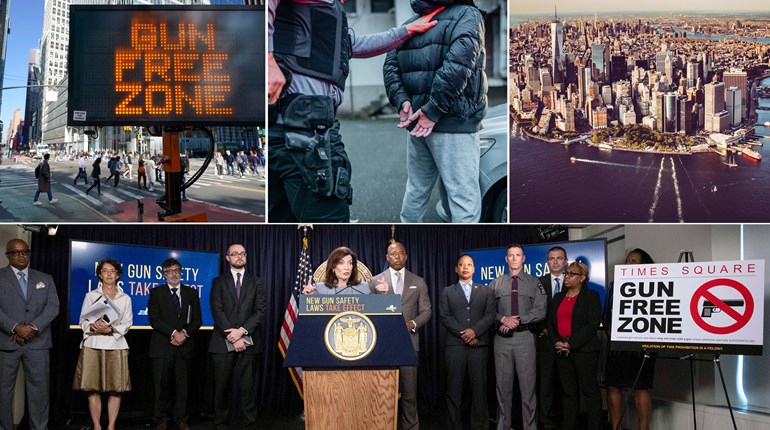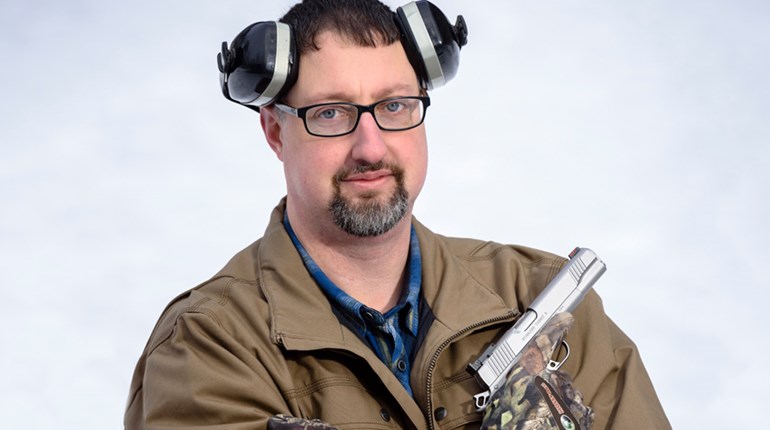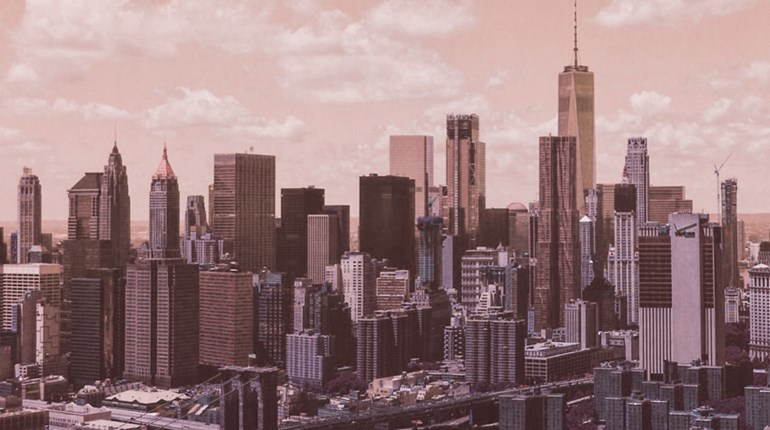
In New York City, where I was born and raised and continue to live, a landmark case coming before the U.S. Supreme Court this fall may allow us to cultivate our gun rights more naturally, as a normal part of our culture and heritage, with the city’s punitive gun laws finally being put to the test.
I was lucky to grow up with firearms—an exception to the rule on Manhattan’s Upper West Side. That’s because, in his late-middle age, my architect father began exploring more of the interests of the old Italian neighborhood of his youth. His kitchen began overflowing with pasta makers and deli slicers. His prep table was overtaken by a home wine-making operation; in fact, we ate our meals beside a glass jug as it bubbled up fermented gas. And, scattered about the living room, tucked in the bookcases and stashed behind the coffee table, he positioned an array of locked cases and bags containing his growing collection of rifles, pistols and shotguns.
The acquisitions that began to fill our doorman apartment mainly came from the shops around Manhattan’s Little Italy. Home winemaking was once common among Italian Americans. So, too, was a well-developed gun culture. There was a time when riflery and marksmanship were encouraged across America—even in New York City. Look at any high-school yearbook from a century ago and you will find a picture of the student gun club. The late U.S. Supreme Court Justice Antonin Scalia, a member of his own New York school’s team, recalled traveling in his youth “on the subway from Queens to Manhattan with a rifle.” Then he asked, “Could you imagine doing that today in New York City?”
Then, as now, unless you were in a business that transported large sums of cash or cash-equivalents, a concealed-carry license was out of the question.
For Americans of Italian descent, an affinity for firearms was a patriotic necessity. The Risorgimento (meaning “resurgence”) was the fight for Italian reunification, and, during my youth, it was still a recent memory for many. In the 1850s, after a first unsuccessful effort, the Italian general Giuseppe Garibaldi had regrouped in Staten Island, bringing with him his partisan supporters, including, so the story goes, my great-great-great-grandfather, a Piedmontese from Cuneo in northern Italy. Loyalty, combat readiness and virtue have long remained in the blood. At the outset of World War I, my great-grandfather (and namesake), Giacomo Panero, an American banker, even voluntarily returned to Italy to join the Alpini, the mountain division of the Italian army. He successfully helped to push the Germans out of the southern Dolomites. His Italian army portraits, in cloak and alpine hat, still adorn my bookshelf.
When I reached the age of 16, it was time for me to join the family ranks. My father brought me downtown to John Jovino Gun Shop to acquire my first firearm. The old gun shop was a small storefront in an alley on the edge of Little Italy, behind the palatial former police headquarters at 240 Centre Street. An oversized pistol hung from its sign, a famous urban marker that made cameo appearances from WeeGee—a famous New York photographer—to “Serpico,” a film starring Al Pacino. Founded in 1911, John Jovino’s was the oldest gun shop in New York, if not in the country, before it was ultimately cut down by the COVID-19 closures of 2020. Back in the early 1990s, as city residents turned to self-defense during the height of the last New York crime wave, business was booming.
The owners were happy to see a first-time family walk through the door. They were, like most gun enthusiasts, some of the nicest people you might meet. We selected a .22-caliber Winchester magnum rimfire rifle, the Marlin 882 SS. The gun’s bolt action is, to this day, a joy to slide. It must have reminded my father of Giacomo picking off those Germans high in the Dolomites. We mounted a magnifying scope on it. To this purchase, my father added a .22 target pistol and .357 Magnum revolver.
New York City’s gun laws are among the most punishing in the country—for law-abiding citizens, at any rate. Merely acquiring the license to keep a firearm in your home and to transport it in a locked bag to a range is a Herculean ordeal. Even during the 1990s crime wave, licensing your firearm was onerous. My father did it by the book. At the time, it required months and months of paperwork, background checks and precise postal money orders that had to be filed with a clerk in the bowels of One Police Plaza. And that was just to keep a pistol at home. Rifles and shotgun permits came through an entirely different but equally laborious process. Then, as now, unless you were in a business that transported large sums of cash or cash-equivalents, a concealed-carry license was out of the question.
At our range, it was thankfully a little different. Tucked two stories below the streets of lower Manhattan, our tidy club was welcoming and laissez-faire. My father went weekly, taking his pistols with him in a nondescript locked bag on the seat beside him on the A train. He said he enjoyed developing his marksmanship. I was also more than free to practice with his firearms. Or I could try out any of the Glocks or other pistols they kept behind the counter. Want to test out a 12-gauge, pump-action shotgun? Fire away. The range also came stocked with food catered from Chinatown. Understandably, it quickly became my high-school hangout.

Later, in his retirement, my father—a multigenerational New Yorker—found he was finally ready to opt out of the city and its gun laws. He left for the country and for freer states. His collection then gained a vintage Browning Auto-5 and a Remington 581S. I joined him often for sporting clays and pistol practice on rural ranges that were worlds away from that one in downtown Manhattan. When my wife came to meet him, he even gifted her a snub-nosed .38 Special. I joked that he gave it to her in the manner of Clemenza handing one to Michael Corleone, just without the tape on the butt. For him, it was a sign of true affection. Now she was family.
In 2003, when the Smith & Wesson company debuted its .50-caliber revolver (the Model 500), my father was first in line to purchase one. He might’ve lived and died an avowed atheist, but he always believed in stopping power, and this gun was designed to stop a bear in its tracks. It could also “put a bullet through an engine block,” he liked to say. When we finally tested it together at a sandpit in the freer state of Vermont, the pistol felt like a piece of personal artillery. A flaming shockwave emanated from the end of its barrel and expanded in a cone of heat and light. “This gun is your inheritance,” he told me, which was more on target than I cared to realize. It was the last time we shot together.
Our times on the range were highlights of my growing up with my father, and I hold close those memories. He taught me the responsibilities of becoming a man. I was also proud of his resolve to exercise his rights against the prevailing diktats of our city.
One thing most New Yorkers realize is that situations can change very quickly. I remember one day, around the time of the Los Angeles riots, all the students in my school were hustled into the auditorium and told to leave immediately and head directly home. The police said there was a concern of lawlessness breaking out in the streets. As I boarded a public bus, a man pulled me aside to say the “revolution is coming.” Whatever he had on his mind, I was comforted to reach home and know that we had protection, even in the heart of New York. It was a sense of security that was different from what everyone else I knew felt that day, and one that I vowed never to give up.
In the 1990s, there were over 2,000 murders a year in the five boroughs. The city had always had many virtues, but the specter of lawlessness, especially at night, was never one of them. One evening, my mother was robbed at gunpoint just steps from Lincoln Center as she walked around the corner from the ATM. She spent the night in a squad car driving through nearby Central Park looking for some disheveled white perpetrator, all in vain.
It seems even worse today. Back then, crime was merely out of control. Now, after two decades of remarkably effective law and order, crime has been willfully encouraged to take hold. We know what works to fight crime—from deploying undercover cops to combating quality-of-life offenses. Today, in cities across the country, not just in New York, many leaders have sadly chosen to follow just the opposite path.
The pandemic has made things worse, but the decline could be felt even before the closures. One Saturday early last year, I ran for a Broadway bus after taking my five-year-old son to a family performance at Lincoln Center. I held his hand as we made our way to a back seat. It was his favorite spot, by the window. The back of the bus was empty except for a young man swaying in the middle of it.
The dynamics of power in New York City seem once again to be shifting into the hands of the ne’er-do-wells, who have only begun to test the limits of what they can do.
As the bus lurched forward, I brushed by the man. Next thing I knew, he jumped me from behind and slammed me into a pole on the bus. Instinctively, I moved to cover my son and steady myself. The man cursed and began to circle us. We should watch “where the F we were going,” he shouted. I sensed our separation from the other passengers. They were mostly elderly and looking back at us in fear. As the bus approached Columbus Circle, the man grabbed something wrapped in a black plastic bag and stormed out the back door.
When I let the bus driver know about the assault, he said the man had evaded the fare by entering through the back door. It turns out he had been menacing passengers before we got on. The driver said there was nothing he could do. I needed to be careful out there, he said, especially with a child. This happened at noon on a Saturday on a city bus. Sometimes it feels like the right to fear is the only right New York City truly offers its law-abiding citizens.
That episode was minor. My son barely noticed it. It could have gone much worse for both of us. The dynamics of power in New York City seem once again to be shifting into the hands of ne’er-do-wells, who have only begun to test the limits of what they can do. The city’s gun laws go to the heart of this imbalance. If you intend to commit a crime, you can almost be assured your victim will have little power to stop you. “If guns are outlawed, then only outlaws will have guns” might as well be the motto on the seal of the City of New York.
The bus incident recalled what my father taught me about stopping power. The police are indeed New York’s finest, but it has always been clear that their power has limits. This is especially true in an age of “defund the police,” the “decriminalization” of law breakers and the vagaries of politicians who seem content to put our most-vulnerable citizens at even greater risk. The only true way to stop crime and disorder is to give organized, responsible New Yorkers the power to protect themselves. We deserve to enjoy the fruits of gun culture naturally, to its greatest potential, without undue interference. More New Yorkers should also be able to grow up with firearms as I did. It’s a free country—or should be—even in New York City.

































